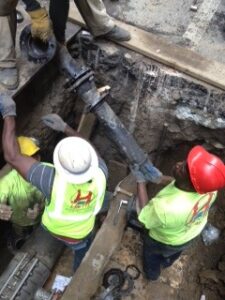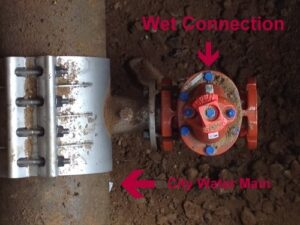Installing new fire sprinkler mains is a routine procedure for most NYC water main & sewer contractors however; there are unexpected factors that may arise as the installation process is taking place.
 In mid-December Harris Water Main & Sewer Contractors was awarded a job to install a new 4” ductile iron sprinkler service and a 3” ductile iron domestic water service for a new building off of 1st Ave in Manhattan. These specifics of this job were straight forward; the city water main was on the “short side” of the street which requires less material and labor, the street was not a “protected street” which means that the onsite crew did not have to worry about a special compaction testing upon backfilling the roadway.
In mid-December Harris Water Main & Sewer Contractors was awarded a job to install a new 4” ductile iron sprinkler service and a 3” ductile iron domestic water service for a new building off of 1st Ave in Manhattan. These specifics of this job were straight forward; the city water main was on the “short side” of the street which requires less material and labor, the street was not a “protected street” which means that the onsite crew did not have to worry about a special compaction testing upon backfilling the roadway.
The general contractor who was managing the renovation of the building had all of the required paperwork (DOB approved plans & Cross Connection Letter) ready for Harris to obtain the required DEP (Department Of Environmental Protection) and DOT (Department Of Transportation) permits to start the project. There was a brief hold before the sprinkler main installation could get started, due to scaffolding on the sidewalk that was being used to assist in some cosmetic repairs to the building.
On the first day of the project the onsite water main crew was to excavate both the roadway and sidewalk in preparation for the piping, which was to take place along with the installation of the wet connections on day 2. The crew finished digging out the job by 4pm and secured steel plates over the holes in the roadway to leave the jobsite safe until they arrived the next morning.
The NYC DEP was scheduled to install the new wet connections at around 10 AM which would allow the onsite crew to complete the installation of the 3” & 4”ductile iron pipe before sundown. As the DEP started to install the wet connection, they encountered a very old and brittle section of the city water main. The DEP onsite crew made a decision that the section of piping had to be replaced to avoid any future issues with the new wet connection that was to be installed.
The DEP had to perform the repair in the middle of the night as they had to shut down the city water main for the entire block and wanted to avoid inconveniencing the surrounding neighbors. The repair of the city water main was completed within 48 hrs and the Harris crew was able to successfully complete the installation of the new wet connection before the next morning. Harris Water was on the jobsite early that morning waiting for the DEP to complete the work which would allow them to finish the installation and pass DEP inspection of the new water mains.
water mains.
The backfill of the holes and cleanup of the job were completed the same night as the pipe installation, the sidewalk and roadway were both permanently restored within 48 hrs of the job being completed
If you have any questions about the specifics of this job or are looking for a free estimate on a water main or sewer line repair or replacement please call us at 718-495-3600 or contact us here.
A Brief History of the Lower East Side NYC
Courtesy of Wikipedia
The Lower East Side, (often abbreviated as LES), is a neighborhood in the southeastern part of the New York City borough of Manhattan. It is roughly bounded by Allen Street, East Houston Street, Essex Street, Canal Street, Eldridge Street, East Broadway, and Grand Street.
It was traditionally an immigrant, working-class neighborhood. But it has undergone rapid gentrification starting in the mid-2000s, prompting The National Trust for Historic Preservation to place the neighborhood on their list of America’s Most Endangered Places. It has become a home to upscale boutiques and trendy dining establishments along Clinton Street’s restaurant row.
The Lower East Side is bordered in the south and west by Chinatown (which extends north to roughly Grand Street), in the west by NoLIta and in the north by East Village.
Politically it is located in New York’s 8th, 12th and 14th congressional districts, the New York State Assembly’s 64th district, the New York State Senate’s 25th district, and New York City Council’s 1st and 2nd district. Historical boundaries
Originally, the “Lower East Side” referred to the area alongside the East River from about the Manhattan Bridge and Canal Street up to 14th Street, and roughly bounded on the west by Broadway. It included areas known today as East Village, Alphabet City, Chinatown, Bowery, Little Italy, and NoLIta.
The exact western and southern boundaries of the neighborhood are a matter of perspective – New York natives and long-time neighborhood residents, especially the Puerto Rican and black community, and the Jewish community, don’t have East Village in their vocabulary, and refer to it as the Lower East Side. The so-called debate about naming conventions typically only applies to the post-gentrification crowd. Most recent arrivals to the area, including new visitors and residents prefer to call the area north of Houston Street the East Village – a name not coined until around 1960.
Although the term today refers to the area bounded to the north by East Houston Street, parts of the East Village are still known as Loisaida, a Latino pronunciation of “Lower East Side.” Avenue C is known directly as “Loisaida” and is home to the Loisaida Festival every summer.




















